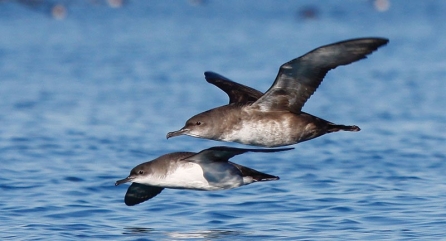Search
11/18: Ten seabirds added to the Mediterranean List of endangered or threatened species
The updated list of endangered or threatened species found in the Mediterranean entered into force in September 2018. It now includes 10 additional bird species classified as endangered or threatened. This list is established under the Specially Protected Areas and Biological Diversity Protocol (SPA/BD Protocol) of the Barcelona Convention.
The Mediterranean is home of several hundred bird species
The Mediterranean Sea is considered an important habitat for seabirds, including particularly the Critically Endangered Balearic shearwater, the endemic Yelkouan shearwater and the little tern.
The ornithological calendar of the Mediterranean is dominated by the seasonal migrations of birds from Europe to Africa in autumn and vice versa in spring. Many species breed in Europe over-winter in the Mediterranean basin. Several marine ones breed in the Mediterranean and migrate to the Atlantic Ocean after the breeding season. Nonetheless, the Mediterranean is the home of several hundred bird species, some of which occur exclusively in this climatic zone.
Ten seabirds added to the Mediterranean List of endangered or threatened species as of September 2018
Article 12 of the Protocol concerning Specially Protected Areas and Biological Diversity indicates that “The Parties shall ensure the maximum possible protection and recovery of the species of fauna and flora listed in the Annex relating to the list of endangered or threatened species”.
Last September ten species of seabirds have been added to the list of endangered or threatened species established under the SPA/BD Protocol. The list is now totaling 25 seabirds:
Seabirds added in 2018:
|
Balearic Shearwater |
Puffinus mauretanicus |
|
Kentish Plover |
Charadrius alexandrinus |
|
Greater Sand Plover |
Charadrius leschenaultii ssp. columbinus |
|
Slender-billed Gull |
Larus genei |
|
Mediterranean Gull |
Larus melanocephalus |
|
Armenian Gull |
Larus armenicus |
|
Common Gull-billed Tern |
Gelochelidon nilotica |
|
Caspian Tern |
Hydroprogne caspia |
|
Pied Kingfisher |
Ceryle rudis |
|
White-breasted Kingfisher |
Halcyon smyrnensis |
Seabirds which were already on the list:
|
Greater Flamingo |
Phoenicopterus roseus |
|
European Storm-petrel |
Hydrobates pelagicus ssp. melitensis |
|
Scopoli’s Shearwater |
Calonectris diomedea |
|
Yelkouan Shearwater |
Puffinus yelkouan |
|
Pygmy Cormorant |
Microcarbo pygmaeus |
|
European Shag |
Phalacrocorax aristotelis |
|
Dalmatian Pelican |
Pelecanus crispus |
|
Great White Pelican |
Pelecanus onocrotalus |
|
Slender-billed Curlew |
Numenius tenuirostris |
|
Audouin’s Gull |
Larus audouinii |
|
Little Tern |
Sternula albifrons |
|
Lesser Crested Tern |
Thalasseus bengalensis |
|
Sandwich Tern |
Thalasseus sandvicensis |
|
Osprey |
Pandion haliaetus |
|
Eleonora’s Falcon |
Falco eleonorae |
Many of the seabird species face threats on land and at sea. On land this includes high pressure from coastal developments affecting availability of breeding and wintering habitats, and predation at colonies from native and invasive species. At sea the main threats include interaction with fisheries (bycatch), the lack of prey caused by depletion of fish stocks and from acute and chronic pollution (oil spills, chemical discharges, etc.), marine litter, and disturbance from maritime traffic.
In addition to seabirds, the list includes 14 different categories of species of fauna and flora, such as algae, mammals, reptiles, fishes, mollusks, etc. To consult the full list, click on this link.
Criteria applied to include species on the list
A species can be added to the list in the following four cases:
- A species can be included on the list if, on the basis of reliable scientific data, it is demonstrated that:
- the species is in decline with a reduction in its numbers of over or equal to 50% observed, estimated, inferred or suspected over the last 10 years; or that
- important reductions (including fragmentation) of its habitats have been observed in the Mediterranean or that;
- the species or its Mediterranean population figures on the IUCN red list as critically endangered, endangered or vulnerable.
- Habitat building species and those at the basis of important biological formations for the Mediterranean may be included on the list if important regressions of the said habitats or of the areas covered by the said formations have been observed, inferred or suspected over the last 10 years.
- A species endemic to a country, or a group of countries, may be included on the list at the proposal of the country, or of the group of countries in question.
- The inclusion on the list may be decided if it proves necessary to the adequate implementation of conservation measures advocated for a species already included in the list.

An Action Plan aiming to maintain and/or restore the population levels of bird species to a favorable conservation status
An Action Plan for the conservation of bird species on the list has been established since 2013 and updated in 2017. The main purpose of this Action Plan is to maintain and/or restore the population levels of bird species listed in the Annex II of SPA/BD Protocol to a favorable conservation status and to ensure their long-term conservation. To this end, the main actions identified are:

Source: UNEP/MAP




Suivez nous sur ...